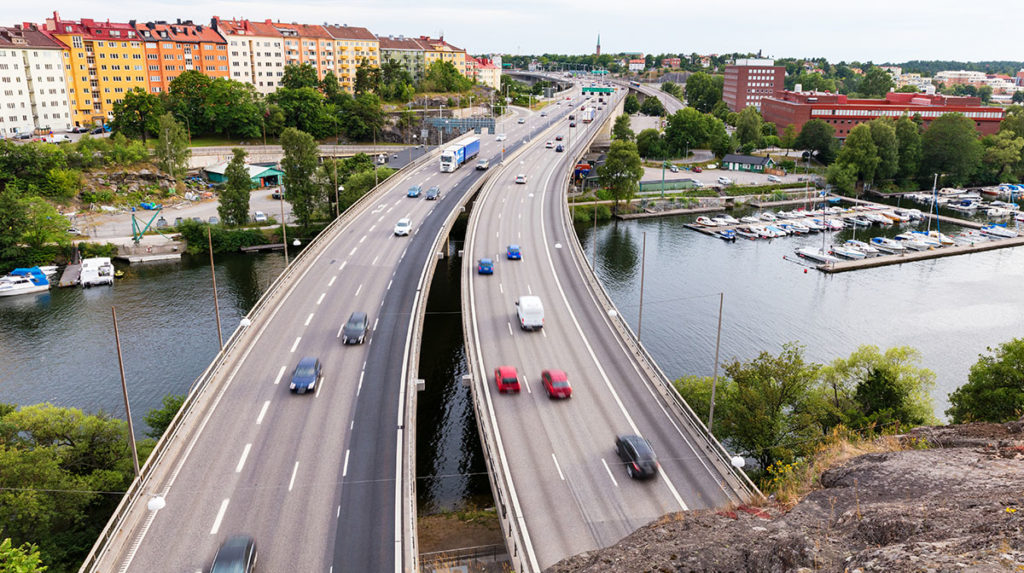
A major CCTV system for Swedish Transport Administration
A major CCTV system for the Swedish Transport Administration (Trafikverket) for traffic monitoring around the Stockholm area and nationwide in Sweden.
The project involved implementing a fully-integrated, IP-based video system to monitor traffic flow on highways and in tunnels in and around the greater Stockholm area. Since 2013, the system has been nationwide and includes four monitoring centers. The two main centers are in Stockholm and Gothenburg. The monitoring centers provide actual traffic information round the clock, all year round. The traffic center in Stockholm is maintained in co-operation with the STA and the City of Stockholm. The system also provides video to other authorities, such as the police and fire departments. In addition to the main monitoring centers, the system includes hundreds of cameras and a local monitoring center in each tunnel.
The system has continued to develop throughout the years, from its start in 1999 until present, and it is still constantly evolving. As of today, the STA system contains approximately 1400 cameras. The latest development was in 2013 when the Gothenburg area was connected to the system (~200 cameras), and in 2014 the North Link tunnel in Stockholm was connected (~350 cameras). Service, support, and extensions have been implemented since 2006.
We selected Teleste as they could deliver a video system completely in accordance with our specification in terms of scalability, distribution and an efficient utilization of IP network.
– Lars Jonsson, Project manager, National Maintenance, Swedish Transport Administration.
Customer need
- Create better co-ordination between different authorities
- Ability to quickly deliver public traffic information via radio, internet or variable road message signs
- Improve safety of drivers by preventive measures. If a vehicle has stopped on a motorway, the operators can warn other drivers by signs, or lowering the speed limits.
- CCTV cameras to create effective decision-supporting tool to choose right course of action
- Improve tunnel safety. If there is a fire in a tunnel, it must be closed immediately so stop more traffic from entering
- Create an easy, efficient work flow for the operators, achieved by full system integration
Solution to customer’s need
- 1400 cameras (and expanding)
- Encoding channels 400
- Distributed recording
- More than 100 decoding channels
- 1 main monitoring center – Trafik Stockholm
- Local monitoring centers in each tunnel
Network
- Gigabit Ethernet backbone
- 155 Mbit radio links
- QoS via RSVP
- 3G/EDGE from road assistance vehicles
The STA network is not dedicated to video transmission only. It is also used for communication between CTS, and all the other subsystems. In a large mixed network, it’s important to have control over the networks usage. The system must be able to handle bandwidth limitations, and prioritization of traffic, therefore, some sort of Quality of Service must be used. Video traffic is sensitive to packet loss, therefore, video should be prioritized over other network traffic.
Functionality
- Redundant servers
- Fully integrated to CTS (Central Technical System)
- High quality: MPEG2@8Mbit/MPEG4@6Mbit
- User rights management – arbitration
- Multicast
Bandwidth manager
Resource Preserving Protocol (RSVP) checks if there is enough bandwidth all the way from the encoder to the decoder. If no bandwidth is available, the video stream will not be connected and the user will be alerted that there is no free bandwidth for the required video stream. Seventy percent of the maximum bandwidth capacity can be utilized in video transmission.

Benefits achieved
- Scalability: In 1999, the project started with approximately 100 cameras, and over the years the system has grown to include more than 1400 cameras (and expanding). New features and modifications have been added over the years. The system is now nationwide. All roads and road tunnels will soon be equipped with cameras.
- Equipment and network: 1400 cameras, distributed recording and decoding channels under four main monitoring centers. There are local monitoring centers in each tunnel. A network consisting of a Gigabit Ethernet backbone, 155 Mbit radio links, QoS via RSVP, and 4G/3G/EDGE from roadside assistance vehicles. Also, the fixed cameras use 4G for places not reached by fiber cables.
- Umbrella system: The Teleste VMX system is the video function for the total operator’s view. The operator’s environment is an umbrella system handling many subsystems; the video is one of these subsystems.
- Public traffic information: Pictures are published every minute on SRAs website www.trafiken.nu for public traffic information. Every morning live video from the Teleste VMX system is distributedto a local TV station, which airs it in their traffic reports.
- Roadside assistance vehicles: The roadside assistance vehicles work 24/7 in co-operation with the police, the STA, and the City of Stockholm. The purpose of these cars is to help maintain high traffic flow and assist and protect vehicles that have suffered from, for example, mechanical failure. It is possible to transmit MPEG-4 video over 3G from the roadside assistance vehicles using the system.
- Continuous operation: The operational system works 24/7. System upgrades are carried out without interfering with operations and there is the possibility for a quick roll-back if the upgrade does not work as it should. Several separate systems have also been integrated since the start of the project. The City of Stockholm’s own stand-alone CCTV system was fully integrated with the system in 2007. A tunnel north of Stockholm has been integrated via ASN.1 protocol (~150 cameras). The latest development involved connecting the North Link tunnel in 2014 (~350 cameras) to the system.